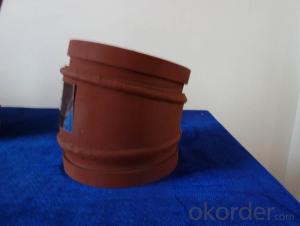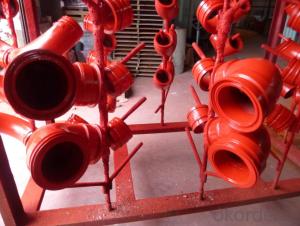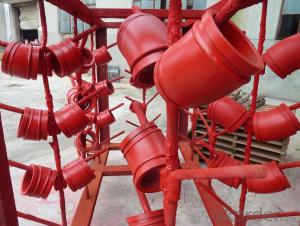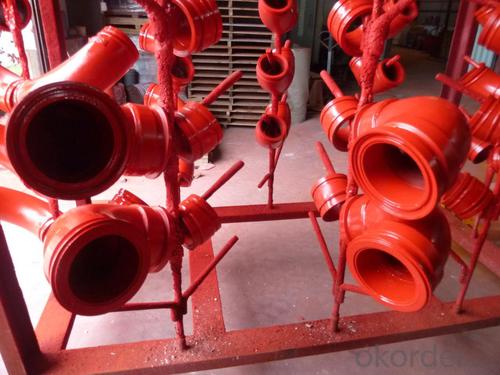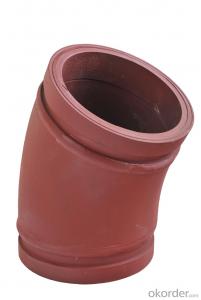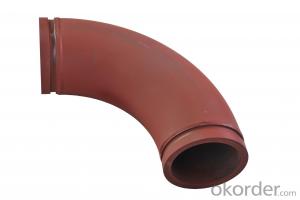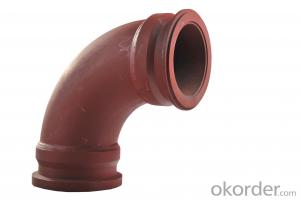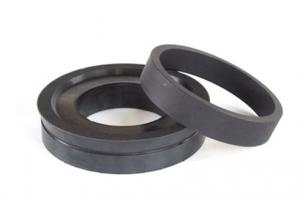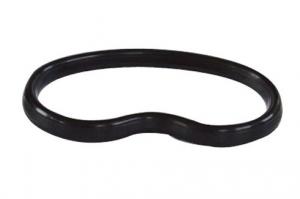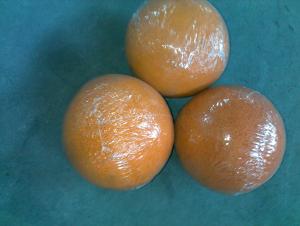Twin Wall Elbow for Concrete Pump R275 15DGR
- Loading Port:
- Tianjin
- Payment Terms:
- TT OR LC
- Min Order Qty:
- 30 pc
- Supply Capability:
- 5000 pc/month
OKorder Service Pledge
OKorder Financial Service
You Might Also Like
Twin Wall Elbow (Twin Wall Flange)
(1) Material: Q235 (outside) + GCr15(inside)
(2) Thickness: 3mm (outside) + 9mm (inside)
(3) Technology: Quenching under high temperature
(4) Characteristics: the inner rigidity to 63 HRC; the outside has so high toughness to keep the inner.
(5) Matched with: Twin wall flange, Alloy (GCr15) + 20#
(6) Working Pressure:170bar
(7) Service life: above 60,000 cubic meters.
(8) Package: PP woven bag and plastic cap
Twin wall elbow is created with research of us and need of the market. Its service life and working pressure are better than the casting. Besides, We can supply 90D, 45D, 30D, 25D, 20D, 15D, 10D. And it can be used for PM, JUNJIN, Schwing, Cifa, Sany, ect.
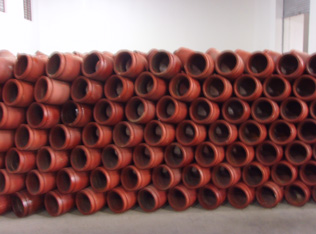
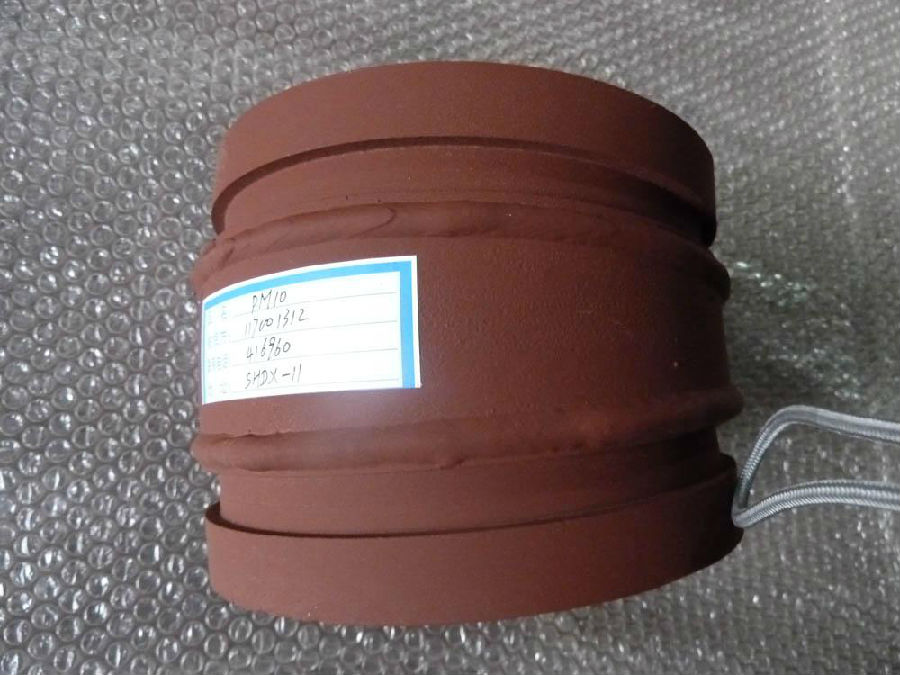
- Q: How often should hopper agitator shaft seals be replaced in a concrete pump?
- Hopper agitator shaft seals in a concrete pump should be replaced as per the manufacturer's recommendations. However, as a general guideline, it is advisable to inspect and replace them annually or whenever signs of wear, leakage, or reduced performance are observed. Regular maintenance and proper lubrication can also help prolong the lifespan of these seals.
- Q: What are the signs of a malfunctioning lubrication system?
- Some signs of a malfunctioning lubrication system include increased friction and heat, unusual noises coming from the engine or components, excessive wear and tear on moving parts, and a decrease in overall performance and efficiency of the machinery or vehicle.
- Q: What are the advantages of using carbon fiber components in concrete pump spare parts?
- Using carbon fiber components in concrete pump spare parts offers numerous benefits. To begin with, carbon fiber is renowned for its exceptional strength-to-weight ratio. This means that carbon fiber components can provide the same level of strength as traditional materials like steel or aluminum, but with significantly less weight. Consequently, spare parts made from carbon fiber are lighter, making them easier to handle and install, while also reducing the overall weight of the concrete pump system. Furthermore, carbon fiber exhibits remarkable resistance to corrosion. Unlike steel, carbon fiber does not rust or deteriorate when exposed to moisture or chemicals. This makes it an ideal material for concrete pump spare parts, as they are constantly exposed to water, cement, and other corrosive substances. The corrosion resistance of carbon fiber ensures the long-lasting durability of the spare parts, diminishing the need for frequent replacements and maintenance. Another advantage of carbon fiber components is their high stiffness. Carbon fiber is well-known for its rigidity and minimal flexural deformation, meaning that spare parts crafted from carbon fiber experience minimal deflection when subjected to heavy loads. This stiffness helps maintain the overall stability and performance of the concrete pump system, ensuring accurate and efficient pumping of concrete. In addition, carbon fiber demonstrates excellent fatigue resistance. Since concrete pump spare parts endure continuous cyclic loading and unloading, they are susceptible to fatigue failure over time. However, carbon fiber components possess the ability to withstand these cyclic loads without compromising their structural integrity. This enhances the reliability and lifespan of the spare parts, reducing downtime and maintenance costs. Lastly, carbon fiber offers unparalleled design flexibility. It can be easily molded into intricate shapes and geometries, allowing for the creation of customized spare parts tailored to specific requirements. This design flexibility empowers the optimization of spare parts' performance, enhancing the overall efficiency and productivity of the concrete pump system. In conclusion, utilizing carbon fiber components in concrete pump spare parts presents a multitude of advantages, including their outstanding strength-to-weight ratio, corrosion resistance, stiffness, fatigue resistance, and design flexibility. These qualities contribute to the enhanced performance, durability, and cost-effectiveness of the concrete pump system.
- Q: What is the farthest pumping distance of concrete pump truck?
- Now the domestic pump to achieve the highest pump height, the largest is ZOOMLION made 80 m carbon fiber boom pump, but also to achieve the pump Guinness world record
- Q: What is the function of a concrete pump control lever?
- The function of a concrete pump control lever is to regulate the flow and direction of concrete being pumped, allowing the operator to precisely control the placement and distribution of concrete during construction projects.
- Q: What is the washing process of the concrete pump pipe?
- Open the first section of the reducing pipe and the discharge gate, and thoroughly remove the remaining concrete in the hopper, the distributing valve box and the reducing pipe.
- Q: Are there any warranties or guarantees available for concrete pump spare parts?
- Yes, there are warranties and guarantees available for concrete pump spare parts. Many manufacturers and suppliers offer warranties to ensure the quality and performance of their products. These warranties typically cover defects in materials or workmanship and provide a certain period of coverage, usually ranging from a few months to a year or more. Additionally, some suppliers may offer guarantees on the performance or durability of their spare parts, providing assurance and peace of mind to the customers. It is always recommended to inquire about the specific warranty or guarantee terms before purchasing concrete pump spare parts to ensure that you are protected in case of any issues.
- Q: Are there any online resources or manuals available for concrete pump spare parts?
- Yes, there are several online resources and manuals available for concrete pump spare parts. Many manufacturers and suppliers have websites where you can find detailed information about various spare parts, their specifications, and ordering details. Additionally, there are online marketplaces and forums dedicated to construction equipment, where you can find comprehensive catalogs, user manuals, and even discussion threads related to concrete pump spare parts.
- Q: Can I get spare parts for concrete pump hoppers and agitators?
- Yes, spare parts for concrete pump hoppers and agitators are generally available.
- Q: What are the indications of a clogged or damaged concrete pump filter?
- Decreased pumping pressure, reduced flow rate, increased fuel consumption, and irregular or inconsistent concrete output are all signs that the concrete pump filter may be clogged or damaged. In more severe cases, a severely clogged or damaged filter can lead to pump overheating or complete shutdown. To ensure optimal performance and prevent potential pump damage, it is crucial to regularly inspect and clean or replace the filter.
Send your message to us
Twin Wall Elbow for Concrete Pump R275 15DGR
- Loading Port:
- Tianjin
- Payment Terms:
- TT OR LC
- Min Order Qty:
- 30 pc
- Supply Capability:
- 5000 pc/month
OKorder Service Pledge
OKorder Financial Service
Similar products
Hot products
Hot Searches
Related keywords
